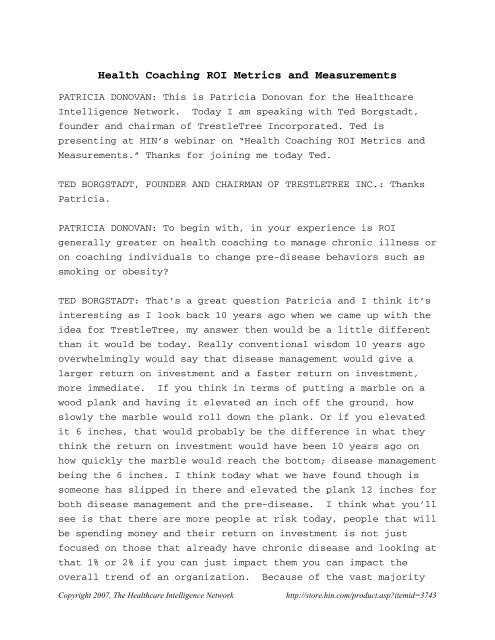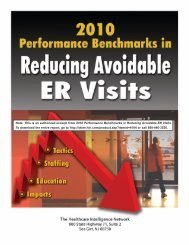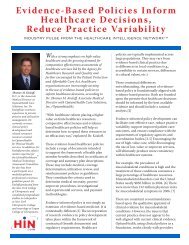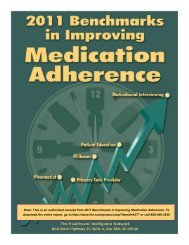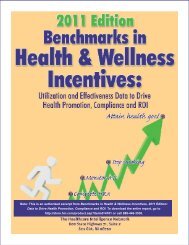Health Coaching ROI Metrics and Measurements - Healthcare ...
Health Coaching ROI Metrics and Measurements - Healthcare ...
Health Coaching ROI Metrics and Measurements - Healthcare ...
Create successful ePaper yourself
Turn your PDF publications into a flip-book with our unique Google optimized e-Paper software.
<strong>Health</strong> <strong>Coaching</strong> <strong>ROI</strong> <strong>Metrics</strong> <strong>and</strong> <strong>Measurements</strong><br />
PATRICIA DONOVAN: This is Patricia Donovan for the <strong>Health</strong>care<br />
Intelligence Network. Today I am speaking with Ted Borgstadt,<br />
founder <strong>and</strong> chairman of TrestleTree Incorporated. Ted is<br />
presenting at HIN’s webinar on “<strong>Health</strong> <strong>Coaching</strong> <strong>ROI</strong> <strong>Metrics</strong> <strong>and</strong><br />
<strong>Measurements</strong>.” Thanks for joining me today Ted.<br />
TED BORGSTADT, FOUNDER AND CHAIRMAN OF TRESTLETREE INC.: Thanks<br />
Patricia.<br />
PATRICIA DONOVAN: To begin with, in your experience is <strong>ROI</strong><br />
generally greater on health coaching to manage chronic illness or<br />
on coaching individuals to change pre-disease behaviors such as<br />
smoking or obesity?<br />
TED BORGSTADT: That’s a great question Patricia <strong>and</strong> I think it’s<br />
interesting as I look back 10 years ago when we came up with the<br />
idea for TrestleTree, my answer then would be a little different<br />
than it would be today. Really conventional wisdom 10 years ago<br />
overwhelmingly would say that disease management would give a<br />
larger return on investment <strong>and</strong> a faster return on investment,<br />
more immediate. If you think in terms of putting a marble on a<br />
wood plank <strong>and</strong> having it elevated an inch off the ground, how<br />
slowly the marble would roll down the plank. Or if you elevated<br />
it 6 inches, that would probably be the difference in what they<br />
think the return on investment would have been 10 years ago on<br />
how quickly the marble would reach the bottom; disease management<br />
being the 6 inches. I think today what we have found though is<br />
someone has slipped in there <strong>and</strong> elevated the plank 12 inches for<br />
both disease management <strong>and</strong> the pre-disease. I think what you’ll<br />
see is that there are more people at risk today, people that will<br />
be spending money <strong>and</strong> their return on investment is not just<br />
focused on those that already have chronic disease <strong>and</strong> looking at<br />
that 1% or 2% if you can just impact them you can impact the<br />
overall trend of an organization. Because of the vast majority<br />
Copyright 2007, The <strong>Health</strong>care Intelligence Network<br />
http://store.hin.com/product.asp?itemid=3743
of the people at risk you’re really seeing more people focusing<br />
on the pre-disease <strong>and</strong> showing true measurable <strong>ROI</strong>. I’ll give<br />
you an example.<br />
One of our clients has a large trucking company. And the<br />
interesting things about trucking companies is that Department of<br />
Transportation regulations if you have diabetes you cannot take<br />
insulin if you have diabetes you cannot drive a truck or if your<br />
blood pressure is above a certain range you cannot drive a truck.<br />
So the average BMI is over 31, the average BMI for this<br />
population is over 31 <strong>and</strong> half of the people smoke. In a three<br />
year study that was done that was concluded just recently, by<br />
their national consultant showed over a 2 to 1 return on<br />
investment <strong>and</strong> most of the individuals that were involved in the<br />
program were pre-diseased. They may be very obese or they may<br />
smoke but they don’t have a chronic condition. The sickest of<br />
the sick were not part of this population <strong>and</strong> yet still showed a<br />
return on investment. What’s interesting is that 25% of the<br />
preventable accidents were averted for participants in<br />
TrestleTree’s coaching program versus those that were not<br />
participating. And it makes sense if you’re getting people to<br />
start to exercise, they’re more alert, they’re losing weight,<br />
they’re stopping smoking there’s going to be less preventable<br />
accidents occur, <strong>and</strong> clearly that’s part of the <strong>ROI</strong> measure. So<br />
in that situation this is not tied to specifically focusing on<br />
the disease management in just the top 1% or 2%, but it did focus<br />
on the broad population with the pre-disease <strong>and</strong> still showed a<br />
solid return on investment.<br />
PATRICIA DONOVAN: I see, thank you Ted. I imagine that population<br />
would have to be extremely motivated too because if they were<br />
educated to the fact that they could be at risk for diabetes then<br />
that would put their job at risk.<br />
TED BORGSTADT: Actually interestingly enough, this is a very<br />
unmotivated population. And I think it’s one of the things<br />
Copyright 2007, The <strong>Health</strong>care Intelligence Network<br />
http://store.hin.com/product.asp?itemid=3743
within transportation if someone is coming upon a Department of<br />
Transportation physical they may do whatever it takes in order to<br />
pass that Department of Transportation physical but what we see<br />
as a truck driving population is very unmotivated population.<br />
And I think that hits on a very key element on return on<br />
investment. Define participation. Or define a participant. It is<br />
a widely held practice in the industry of disease management <strong>and</strong><br />
wellness today to cherry pick participants, which means that<br />
they’re really looking for the ones that are most motivated. Or<br />
the ones that are most severe or spent the most last year <strong>and</strong><br />
allowing them into intensive health coaching relationship <strong>and</strong> all<br />
of the others that are the mass of the population they just give<br />
access to information or brochures that are sent to the home. I<br />
think that’s a key component within our industry today. We have<br />
to be able to show outcomes for the unmotivated that still can<br />
show a return on investment when you’re working with the large<br />
population.<br />
I heard Dr. Jim Prochaska speak just recently, the Executive<br />
Director of the Cancer Prevention Research Center at the<br />
University of Rhode Isl<strong>and</strong>. He’s the godfather of the<br />
Transtheoretical Model of Change. And he stated that he felt like<br />
this was the last chance we had to get health <strong>and</strong> wellness right<br />
for corporate America. He said 25 years ago, as an industry we<br />
screwed things up <strong>and</strong> did not show the return on investment, the<br />
CFO did not recognize the impact on the organization <strong>and</strong> it was<br />
really more focused on right information to the right person in<br />
kind of a brown bag lunch approach. And what he said is that this<br />
is our last chance. If we don’t get it right this time, he<br />
doesn’t think we’ll get another chance, at least in his lifetime.<br />
So return on investment is a very timely top of mind conversation<br />
to be having right now in conjunction with disease management <strong>and</strong><br />
health <strong>and</strong> wellness companies.<br />
PATRICIA DONOVAN: Thank you Ted. And talking about measuring <strong>ROI</strong><br />
does the coaching method that an organization uses for example,<br />
Copyright 2007, The <strong>Health</strong>care Intelligence Network<br />
http://store.hin.com/product.asp?itemid=3743
telephonic versus web based effect <strong>ROI</strong> measurement? And if so,<br />
how?<br />
TED BORGSTADT: I think there are several elements that come to<br />
mind in trying to compare <strong>and</strong> contrast phone versus web. And I<br />
think the motivation component is top of mind. If somebody is<br />
highly motivated <strong>and</strong> they have some type of vehicle to give<br />
accountability a web site, an email accountability, something<br />
that’s electronic <strong>and</strong> is given good information they’re probably<br />
going to show some outcomes. Within our population <strong>and</strong> the<br />
country today that probably comprises 10% to 15% of the total<br />
population. So when you think about the difference between web<br />
<strong>and</strong> telephonic there are some things that you can do via<br />
telephone that you just can’t do regardless of the artificial<br />
intelligence that you’ve built into your website, the algorithms<br />
that you’ve built in that you can try to model what happens. The<br />
reality is at least with TrestleTree’s health coaching, we really<br />
spend an inordinate amount of time training our coaches. We have<br />
two psychologists who train our coaches. And we spend 5 weeks of<br />
training in a classroom setting with psychologist to train<br />
coaches how to connect <strong>and</strong> build a relationship of trust<br />
telephonically with less motivated people. The reason is because<br />
that earns them the right to influence their behavior, health<br />
behavior change, toward health behavior change. And I think<br />
that’s probably the biggest difference between phone <strong>and</strong> web.<br />
With TrestleTree’s health coaching we really train our coaches to<br />
be craftsmen <strong>and</strong> to be craftsmen of underst<strong>and</strong>ing not only<br />
someone’s health life, but also the nuances <strong>and</strong> often times<br />
subtle nuances around family life, work life, the relationships<br />
that are involved in each of those, the pressures <strong>and</strong> stress<br />
around finances. And when you hone those things in context <strong>and</strong><br />
you’re able to peel back the story of someone’s health <strong>and</strong> you<br />
have a uniquely trained coach, they’re able to hold all those<br />
things at one time <strong>and</strong> be able to match them with the right type<br />
of goal to help move them forward. That’s a very, very, very<br />
Copyright 2007, The <strong>Health</strong>care Intelligence Network<br />
http://store.hin.com/product.asp?itemid=3743
difficult thing to do <strong>and</strong> to mirror is more art than it is<br />
science, <strong>and</strong> it’s tough to do via web. So I think there is<br />
definitely a place for a web, but I think you have to look at<br />
that realistically <strong>and</strong> that it’s going to be limited to those<br />
that are most motivated. And I think that it takes something<br />
significantly different, <strong>and</strong> significantly different than just<br />
telephone. It’s someone who truly is trained. It’s not just<br />
because you’re talking with a live person on the phone. It’s<br />
someone who is skilled at being able to connect with you <strong>and</strong> put<br />
a plan in place that will match <strong>and</strong> help move you forward.<br />
PATRICIA DONOVAN: Thanks Ted. Since you brought up the training<br />
of your coaches, do you teach positive psychology at all?<br />
TED BORGSTADT: We use a lot of things, Patricia. We’re not<br />
purists. We’re pragmatists. And so we do use a Transtheoretical<br />
Model of Change as our foundation, but we have constructed a 10<br />
story building on top of that. There’s great utility to what Dr.<br />
Prochaska has put together in the state of change <strong>and</strong> being able<br />
to st<strong>and</strong>ardize training <strong>and</strong> semantics. We use a lot of different<br />
influencing strategies that we teach our coaches <strong>and</strong> so it’s not<br />
linear. It’s multiple things that we put into our coaching.<br />
PATRICIA DONOVAN: Okay. Thank you Ted. And finally in regards<br />
to telephonic health coaching, what is the most important element<br />
of a coach’s performance that you can evaluate, <strong>and</strong> how would you<br />
measure this?<br />
TED BORGSTADT: The most important element for a coach’s<br />
performance is influence. That’s what TrestleTree is about, how<br />
do you influence someone to change a tough health behavior,<br />
specifically if they’re less motivated or unmotivated? And we do<br />
that by building relationships of trust with them over the phone.<br />
We voraciously measure this actually in multiple ways. Within our<br />
software we do track a lot of things that the coaches do,<br />
outcomes that they show, for example, our appointments with our<br />
Copyright 2007, The <strong>Health</strong>care Intelligence Network<br />
http://store.hin.com/product.asp?itemid=3743
participants are at a scheduled time. So we’re able to see what<br />
type of show rate, or people showing up for the appointments they<br />
have scheduled, <strong>and</strong> there seems to be some indication that if a<br />
coach is connected with someone, has a relationship built with<br />
them is exerting influence that they’re going to show up for<br />
their appointments. That’s one of the measures that we look at.<br />
Second is one that we’ve built a tracking mechanism that tracks<br />
the movement <strong>and</strong> stage of change across 6 different goal areas at<br />
the same time. So every time a coach speaks with someone on the<br />
phone, they are actually monitoring, discerning <strong>and</strong> documenting<br />
where they are in a stage of change around medication adherence<br />
monitoring of their condition, a food goal, <strong>and</strong> activity or<br />
exercise goal, stress goal, as well as a tobacco cessation goal.<br />
This is all based on evidence based guidelines that we have built<br />
into our software. So we’re able to give some accounting on the<br />
movement <strong>and</strong> stage of change, but it’s based up on the evidencebased<br />
guidelines that are unique to that individual’s<br />
comorbidities <strong>and</strong> conditions. That’s another way that we measure<br />
our coaches.<br />
And two other things come to mind, graduation rate. TrestleTree<br />
is about helping people change behavior, not helping people build<br />
a co dependent relationship. But really graduate them once that<br />
behavior has been changed <strong>and</strong> they have a good plan in place how<br />
to sustain that change. And then finally I would say the changed<br />
behaviors of somebody who comes in who is a person who smokes,<br />
were we successful in helping them change their behavior to<br />
become tobacco free? If somebody is not exercising were we<br />
successful, regardless of where they came in, if they hadn’t<br />
exercised for 20 years we’re still on the hook to help this<br />
person move through the stages of change <strong>and</strong> actually meet an<br />
evidence based medicine guideline on activity level or exercise<br />
level. Those are the four things that we look at for measuring<br />
our coaches. Show rate, movement in stage of change, graduation<br />
rate, <strong>and</strong> then the actual changed behavior.<br />
Copyright 2007, The <strong>Health</strong>care Intelligence Network<br />
http://store.hin.com/product.asp?itemid=3743
PATRICIA DONOVAN: Well thank you Ted. Those are all the questions<br />
I have today. I want to thank you for being with us <strong>and</strong> we’re<br />
looking forward to hearing more from you during the webinar.<br />
Copyright 2007, The <strong>Health</strong>care Intelligence Network<br />
http://store.hin.com/product.asp?itemid=3743


